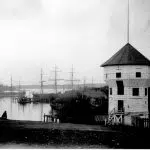
B.C.’s northern spotted owl breeding facility welcomes disabled California relative
LANGLEY, BRITISH COLUMBIA, B.C. — A northern spotted owl found injured near San Francisco has arrived at a British Columbia breeding facility where the adult male is expected to find a mate and potentially contribute to a strengthened gene pool for the threatened species.
It took months of logistical work to bring the owl nicknamed Cali to the Northern Spotted Owl Breeding Program in Langley after rehab stints in California and Oregon, says Jasmine McCulligh, a spotted owl specialist and breeding program co-ordinator.
“We’ve been anxiously awaiting him for literally a year,” she said in an interview. “He’s just going to be so important to the breeding program. It gives his life some purpose. Instead of just sitting in a aviary, he’s going to contribute to the future of his species.”
Four-year-old Cali brings the potential to help produce stronger offspring if he finds a mate among the female spotted owls at the Langley facility, McCulligh said.


